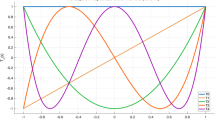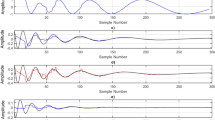Summary
The various data processing techniques (downward continuation, first and second derivatives and their downward continuation) used in gravity interpretation, are analogous to different types of linear filtering operations whose theoretical filter (amplitude) responses can be derived from\((u^2 + v^2 )^{N/2} \exp (d\sqrt {u^2 + v^2 } )\) by suitably choosingN andd, whereu andv are angular frequencies in two perpendicular directions,d the height or depth of continuation in unit of grid interval; andN denotes the order of the vertical derivative. By incorporating a mathematical smoothing function,\(e^{ - \lambda (u^2 + v^2 )} \) (λ being the smoothing parameter) in the theoretical filter response function, it has been possible, by selecting a suitable value of smoothing parameter, to establish an approximate equivalence of the effect of the mathematical smoothing with the inherent smoothing introduced, because of the numerical approximation (approximation error) for practically all data-processing techniques. This approximate equivalence leads to a generalized method of computing sets of weight coefficients for various data-processing techniques from filter response matching method. Several sets of weight coefficients thus have been computed with different smoothing parameter. The amplitude response curves of the various existing sets of weight coefficients have also been calculated for assessing the quality of the approximation in achieving the desired filtering operation.
Similar content being viewed by others
References
B. N. P. Agarwal andT. Lal (1969),Calculation of the second vertical derivative of gravity field, Pure and Applied Geophysics76, 5–16.
B. N. P. Agarwal andT. Lal (1972a),Application of frequency analysis in two dimensional gravity interpretation, Geoexploration10, 91–100.
B. N. P. Agarwal andT. Lal (1972b),A generalised method of computing second derivative of gravity field, Geophysical Prospecting20, 385–394.
B. N. P. Agarwal andT. Lal (1972c),Calculation of the vertical gradient of the gravity field using the Fourier transform, Geophysical Prospecting20, 448–458.
V. Baranov (1953), Calcul du gradient vertical du champ de gravité on du champ magnétique, Measuré à la surface du sol, Geophysical Prospecting1, 171–191.
F. S. Grant andG. F. West (1965),Interpretation theory in applied Geophysics, McGraw Hill, New York, 583pp.
R. C. Henderson (1960),A comprehensive system of automatic computation in magnetic and gravity interpretation, Geophysics25, 569–585.
L. J. Peters (1949),The direct approach to magnetic interpretation and its practical application, Geophysics14, 290–319.
M. B. Zadro (1969),An ideal isotropic bidimensional filter and its application in the interpretation of gravity anomalies, Studia Geoph. et Geoed.13, 239–251.
Author information
Authors and Affiliations
Rights and permissions
About this article
Cite this article
Agarwal, B.N.P., Singh, J. A generalized method for various data processing techniques in gravity interpretation. PAGEOPH 114, 975–982 (1976). https://doi.org/10.1007/BF00876196
Received:
Issue Date:
DOI: https://doi.org/10.1007/BF00876196




